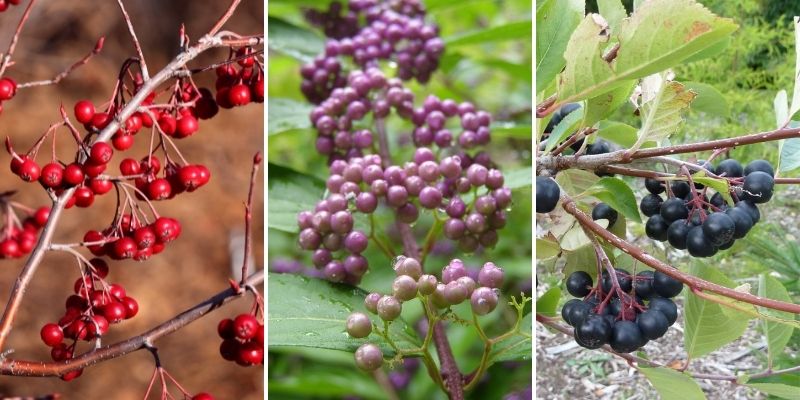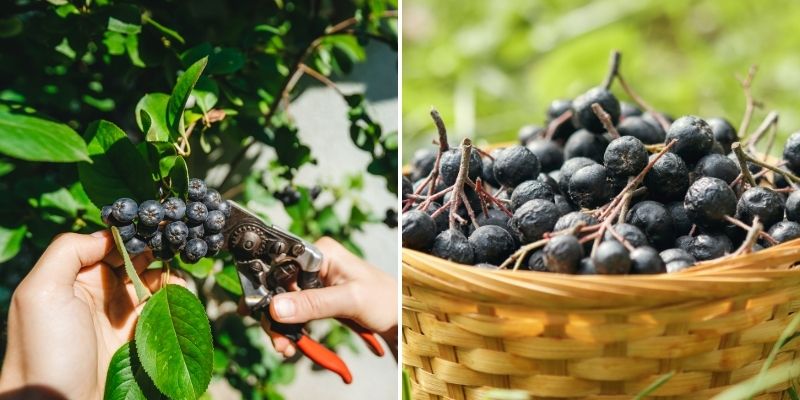Little known in France, Aronia is a bush native to North America worth discovering. Traditionally, indigenous peoples used its berries for food and for medicinal purposes. Introduced to Russia and Scandinavia more than a century ago, this plant is now cultivated there for its small edible fruits.
Depending on variety, berries are black, purple or red. Although they look a lot like blueberries, they are more astringent and taste closer to blackcurrant. But, eaten fresh, their flavour is not very pleasant. This is why Aronia is most often processed: into jelly, into juice, dried, etc. Many virtues are attributed to these berries.
Beyond its fruits, Aronia has several assets. This bush, which can reach 2 m tall, is perfect for creating a windbreak hedge. Very melliferous, it attracts many pollinators during spring flowering and, in autumn, its foliage turns moreover a magnificent purplish-red. It is not very demanding about soil and appreciates sunny or semi-shaded situations. In short, a bush to adopt!
Here are some tips to dry these precious berries.
Which varieties to choose for consumption?
If the three main types of Aronia – with red fruits (Aronia arbutifolia), purple (Aronia prunifolia) or black (Aronia melanocarpa) – are edible, varieties with purple and black berries are generally preferred. Moreover, Aronia prunifolia 'Nero' and 'Aron' are the varieties most commonly grown for consumption.

Aronia arbutifolia (photo Mr.TinDC - Flickr), Aronia prunifolia (photo Chris Light - Wikimedia) and Aronia melanocarpa (photo Wendy Cutler - Flickr)
When and how to harvest Aronia berries?
After spring flowering, corymbs give way to berries that colour over the months. They reach ripeness from late August and can be picked until October.
To harvest the fruits, nothing could be simpler. Using pruning shear, cut clusters at their base in dry weather and shake them gently to remove any insects.
Once picked, berries are detached from clusters and rinsed under water. They should be processed quickly to preserve as many active compounds as possible. If harvest is not large enough to make jelly, for example, the best solution is to freeze the berries until you have enough to prepare what you want, thereby preserving their properties.

Cut your berry clusters using pruning shear
How to dry the berries?
Once Aronia berries have been picked, they should be washed and carefully dried with a clean cloth or absorbent paper. Proceed then to the actual drying, which is one of the simplest ways to preserve Aronia.
Three main methods are available: sun, oven or dehydrator.
Sun drying
Sun drying is only suitable for particularly hot, dry regions, especially since fruits ripen from August to October, quite late in the season. Drying will take several days, even up to a week.
Arrange berries in a single layer on a tray. It is better that they do not touch, avoiding contact points favourable to mould. Cover with a light cloth to keep insects away from your harvest. Turn berries regularly over the days so drying is homogeneous. Remove damaged fruits or those beginning to mould as you go.
Oven drying
For other regions where sun is insufficient, the oven can be a good alternative, provided a very low temperature can be selected.
Place baking paper on an oven tray, then spread berries on it. They must not touch.
Set oven to 40–50°C; above this you risk cooking the fruits, which is not the objective. During drying, leave oven door ajar so moisture can escape. This will result in better drying. The process will take a few hours, probably between 4 and 6 hours.
This technique is quite accessible but energy-consuming.
Dehydrator drying
For those with a dehydrator, this method is recommended. Berries will then dry evenly and at low temperature. Drying is also less energy-hungry than with an oven.
Arrange Aronia fruits on a dehydrator tray, leaving space between them so air can circulate well.
For drying time, refer to your dehydrator manual, as it varies by model.
How to store the berries?
Once dried, berries should be kept away from air and light, in an airtight glass jar, for example. At the first sign of condensation on walls, remove berries and re-dry slightly in the oven, as this moisture indicates drying was incomplete.
Optimal shelf life for dried berries is one year. After that, fruits gradually lose their flavour and nutritional qualities.
How to use the berries?
Dried Aronia berries can be eaten as is, since drying softens their flavour.
They can also be added to muesli, yoghurt or compote for a vitamin boost at breakfast. More broadly, you can incorporate this little berry with many virtues into all desserts such as cakes, crumbles and muffins.
→ Discover different recipes and uses in our tutorials: How to make an infusion of Aronia berries? and How to make homemade Aronia jam?

Aronia berry tart (photo freestocks.org - Flickr)
Virtues of Aronia
In terms of medicinal virtues, Aronia is said to be very rich in antioxidants, even more than goji berry, which would make it an extraordinary ally in prevention of certain cancers and cardiovascular diseases.
It could also have a positive effect on hypertension, not to mention its potential to stimulate digestive pathways and the immune system.
→ For more information on growing this bush, consult our dossier on Aronia: plant, prune and maintain
































Comments